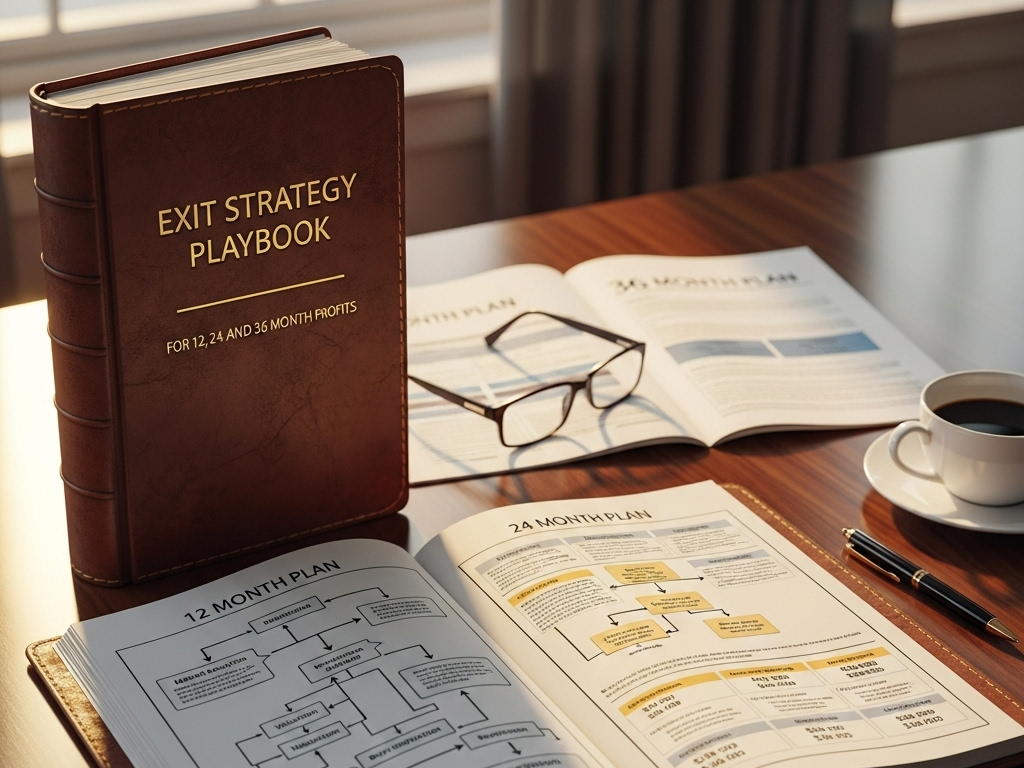The Ultimate Exit Strategy Playbook: Profitable 12–24–36 Month Scenarios, Resale Liquidity & Value-Retaining Furnishing Packages
Whether you’re a real estate investor, short-term rental host, or vacation property owner, having a well-defined exit strategy is critical for maximizing profits and minimizing risk. Too often, property owners focus solely on acquisition and income potential without a clear roadmap for when and how to exit. This article provides a comprehensive Exit Strategy Playbook, focusing on three key holding periods: 12, 24, and 36 months. We’ll discuss how to optimize resale liquidity and increase asset value through strategic furnishing packages that retain appeal and performance. If you’re looking to create flexibility, optimize return on investment (ROI), and make your exit as smooth and profitable as your entry, this guide is for you.
Why Exit Planning Is Critical for Real Estate Investing
An exit strategy isn’t just about selling or walking away — it’s about building optionality, protecting capital, and ensuring you’re not caught unprepared in volatile markets. Every investment should begin with a plan for how and when you’ll exit.
Here’s why a solid exit plan matters:
⦿ It informs your renovation and furnishing budget.
⦿ It shapes your financing and cash flow strategy.
⦿ It impacts your marketing and branding approach during ownership.
⦿ It determines long-term sustainability and profitability.
Exit timelines can vary depending on market dynamics, personal goals, or economic conditions. That’s why we evaluate three defined strategies: 12, 24, and 36-month scenarios. Each has its own risks and rewards, and your chosen path should align with your business goals, local demand trends, and property type.
Exit Strategy Scenarios: 12, 24, and 36 Months Explained
Understanding the unique attributes of short-, medium-, and long-term exit timelines unlocks smarter decision-making and better ROI. Here’s how they compare:
⦿ 12-Month Flip or Short Hold:
Ideal for investors looking for fast ROI. This approach involves purchasing below market value, making light renovations, and exiting quickly at a profit. Risk is higher due to market volatility.
Advantages:
– Quick turnaround
– Less exposure to long-term market changes
– Ideal for hot or appreciating markets
Disadvantages:
– High capital gains taxes (short-term)
– Higher pressure to buy low and sell high quickly
– Riskier if market softens post-purchase
⦿ 24-Month Mid-Term Hold:
Gives you more room to generate cash flow through rentals while preparing for a strategic exit. A two-year holding period opens opportunities for tax advantages on long-term capital gains.
Advantages:
– Time to build up cash flow and financial track record
– Long-term capital gains treatment
– Easier to sell with proven ROI
Disadvantages:
– Need to maintain furnishings and updates for 2 years
– Mid-range cash flow vs. long-term holds
⦿ 36-Month Long-Term Appreciation:
Allows for meaningful brand development, higher property appreciation, and potentially stronger portfolio leverage for your next deal.
Advantages:
– Strong potential for appreciation
– Time to build sustainable systems (e.g. property management)
– Ideal for 1031 exchanges or legacy planning
Disadvantages:
– Market fluctuations over time
– Potential for higher maintenance costs
Boosting Resale Liquidity with Value-Retaining Design Choices
Liquidity—how easily and quickly you can sell the asset—is crucial to any successful exit. Properties that are move-in ready, attractively designed, and performance-documented sell faster and often command higher prices. Furnishings and design can dramatically impact the speed and success of your resale.
Here’s how to enhance resale liquidity:
⦿ Choose universally appealing colors and layouts.
⦿ Invest in high-quality, neutral furniture that photographs well.
⦿ Avoid overly personal or polarizing styles (e.g. loud patterns).
⦿ Ensure all major appliances and fixtures are updated.
⦿ Create a clear performance history if used as a rental (Airbnb stats, occupancy rates, etc.)
Buyers love turnkey properties with proven income. Whether you’re selling to an investor or end-user, a well-furnished property that screams “low effort” is worth more.
Furnishing Packages That Retain Value: Design with Exit in Mind
It’s not just how your property looks today — it’s about ensuring your furnishings hold value over time. Thoughtful furnishing packages can be repurposed, resold, or even reused in future projects. By thinking ahead, you save money and increase future flexibility.
Design tips for value-retaining furnishings:
⦿ Prioritize durability: Opt for stain-resistant, high-quality fabrics.
⦿ Modular choices: Furniture that fits multiple layouts or can be repurposed.
⦿ Timeless finishes: Wood over lacquer, neutral tones over trends.
⦿ Vendor selection: Work with suppliers offering resale or repurchase options.
⦿ Document everything: Receipts, warranty info, and a detailed furnishing list all aid resale.
You can also offer furnished resale as a value-add when selling. This enhances appeal for other investors seeking turn-key opportunity or homeowners who just want to move in.
Conclusion
A smart, structured exit strategy can mean the difference between mediocre ROI and long-term success in real estate investing. Whether your plan is a quick flip, mid-term cash flow hold, or a long-term appreciation play, aligning your furnishing choices and property presentation with your exit timeline is key. Thoughtful design not only elevates guest experience during ownership but directly impacts resale value and liquidity.
Start thinking of furnished real estate like a complete asset — not just location and structure, but style, performance, and turn-key appeal. With a well-executed exit strategy, you’ll be ready for anything — whether the market shifts, your goals change, or an irresistible new investment opportunity knocks.
Take time to define your timeline, secure value-retaining assets, and craft your property experience with your exit in mind. That’s the ultimate playbook for real estate success.

